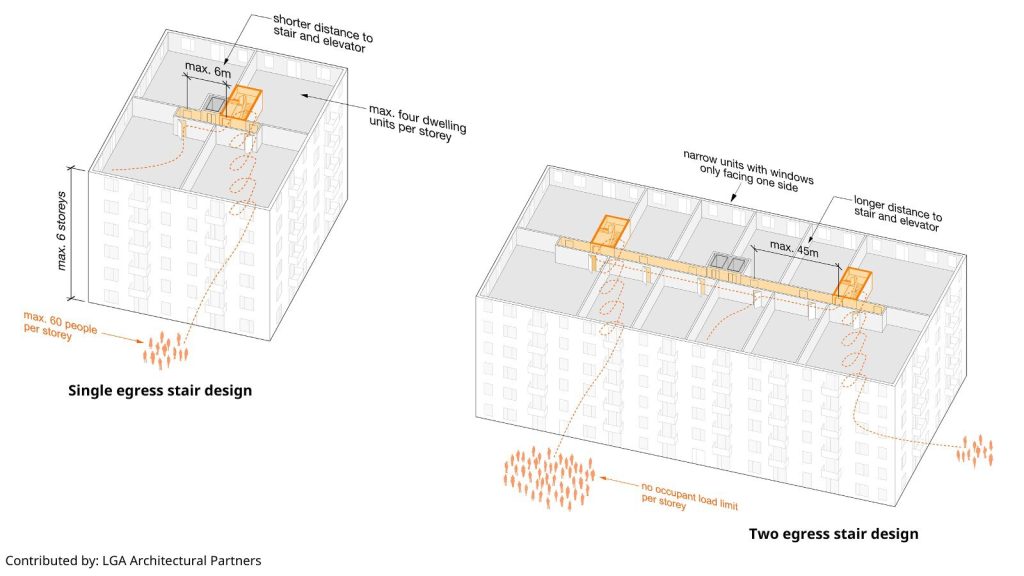Single-exit stairways should be allowed in more, taller B.C. buildings: housing minister

Posted June 28, 2024 6:52 pm.
Last Updated July 8, 2024 12:54 pm.
B.C.’s minister of housing announced Thursday that, after commissioning a report on buildings with only one staircase, the province is one step closer to altering its building code.
Minister Ravi Kahlon tells CityNews that the report found buildings with single egress stairs (SES) allow for more options to fit a variety of lots, can be more environmentally friendly, and are just as safe as the alternative. Kahlon says he is now working towards introducing code changes to allow SES.
The report was conducted by Jensen Hughes, a U.S.-based engineering and consulting services company. It concluded that the ministry should find it technically and economically feasible to allow bigger buildings in B.C. to be constructed with a single staircase.

Historically, in the province and most of North America, the code has only allowed for buildings below two or three storeys tall to have a single staircase. Kahlon says the proposed changes would allow for SES buildings up to six storeys.
He says some U.S. cities and nations all over the world already benefit from SES.
“SES buildings up to six storeys is not only happening across the world, even in Seattle, New York, but it can be done in a way that you can mitigate risks,” said Kahlon.
“The benefits, of course, are, this type of housing allows us to, in smaller buildings, have bigger units, have more two- and three-bedroom units because of the way you can design buildings. It allows for housing to be built on less land — often you require lots of land assembly, you have to buy lots of parcels of land, [SES building] can be done, and in fact, fit better in neighborhoods. And of course, buildings can be built more climate-friendly because of the way that air can flow throughout the building. So there is a ‘triple-word score’ here.”
The report says code requirements regarding SES designs in B.C. have not been updated since 1998.
Vancouver-based architecture designer Bryn Davidson says he’s not the only one who’s been waiting a long time.
“It’s a change that a whole group of us in B.C. and across North America have been advocating for over the last several years,” said Davidson.
“We’re very excited, because we feel like this is really an important step, both for housing action and climate action across the province.”
Davidson called Canada’s the “single most restrictive building code on the planet,” adding that stagnation has been due mostly to “bureaucratic inertia.”
In terms of design, Davidson, who is co-owner and lead designer at LaneFab Design, says SES can benefit “both form and function.”
“It lets you get rid of that god-awful double-loaded hallway. You know when you go into a hotel or into a condo building and you have this long hallway with doors on each side and no windows, and each of those units is like a little shoe box with little windows just on the end, and then you end up with these internal bedrooms with no windows at all?” said Davidson.
“By contrast, when you have a single stair, it’s more like a condo tower where you can wrap all the units around that single stair in the middle, and it’s much, much easier to do really nice two, three, four-bedroom units where the bedrooms aren’t inside, where there’s daylight, cross ventilation, everything that’s nice about how to make multi-family housing work. It becomes infinitely better if you’re allowed to just wrap those units around a single stair.”
Davidson says the potential footprint of SES buildings is part of the solution to the housing crisis across the continent.
“This is what’s been missing. It’s the missing piece. You know — talk about missing middle — but this is the missing design option that we’ve been waiting for in North America.”
SES buildings were originally ruled out by Canadian codes due to safety concerns, but Kahlon says technology has come a long way since then.
“The report clearly lays out that there’s things that can be done to mitigate risks: having wider stairwells so that if people are getting down, there’s more space for firefighters to get up; limiting the amount of units; limiting the amount of height; having sprinkler systems. I mean, some would argue with the new technology that, with sprinkler systems and fire alarms, and pressurized corridors, these buildings, in fact, will be safer than the buildings that we have in our existing housing stock,” said Kahlon.
He says he understands why some people may be hesitant about changes to building codes, but that it’s all part of progress.
“I think the building code is an evolving document. And it should be as technology evolves, as the research evolves, we need to. And I appreciate change can be scary at times. And I know that when mass timber buildings were introduced 15 years ago, there was a lot of concern about what that would mean. And now we have 80 stories of mass timber being accepted across North America as part of the code. And so, any change will take time. But I do believe that this report is pretty clear that there’s a pathway to do this in a safe way.”
Kahlon adds that SES designs allow for elevators and have the potential to be even more accessible than the alternative.
He says the report and the changes have been something architects and engineers have been suggesting to him since his first week as minister. A video by a popular Vancouver urbanist YouTuber about SES design and its many benefits, Kahlon says, was a big part of the inspiration to commission the report in January.
Kahlon says he intends to do some more “engagement” on the subject, but his staff is drafting changes to the code, which he hopes will be enacted in the fall of this year.








